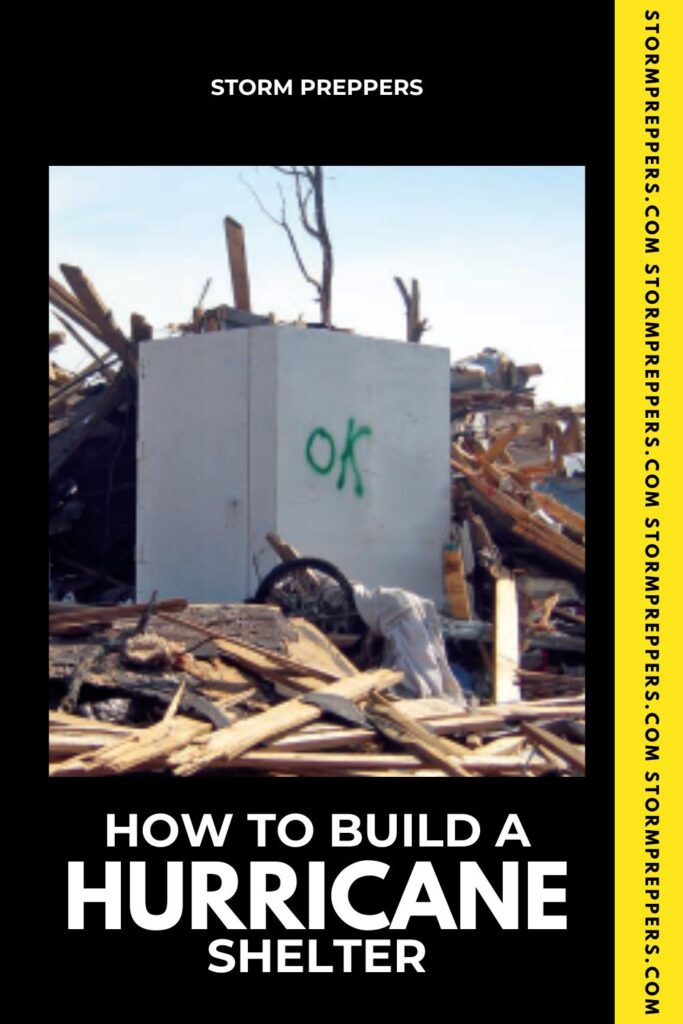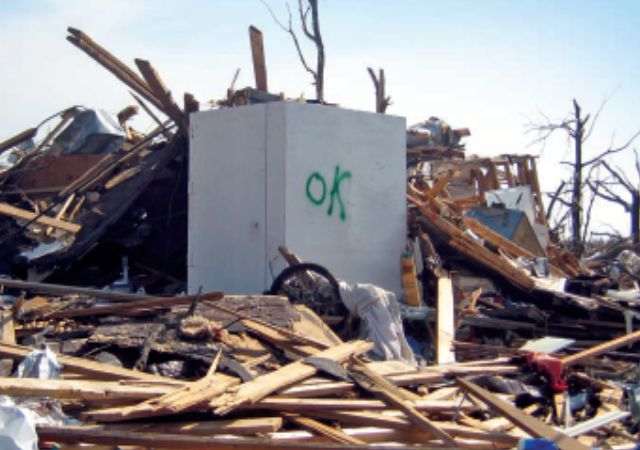If you live in an area prone to hurricanes, it’s important to have a plan in place for how you and your family will stay safe during a storm. One of the best ways to protect yourself is by building a hurricane shelter. These shelters can provide a safe place to ride out the storm, protecting you from high winds, flying debris, and flooding.
When it comes to building a hurricane shelter, there are several factors to consider. First and foremost, you need to decide on the location of your shelter. Ideally, it should be located on high ground and away from any potential flood zones. You’ll also need to consider the size and type of shelter you want to build, as well as the materials and tools you’ll need to complete the project. With careful planning and preparation, however, building a hurricane shelter can be a manageable and worthwhile project that provides peace of mind during hurricane season.
Understanding Hurricanes
Hurricanes are powerful storms that can cause significant damage to homes and communities. If you live in an area that is prone to hurricanes, it is important to understand what they are and how they work.
Impact of Hurricanes
Hurricanes can cause a range of impacts, including:
- High winds: Hurricanes can produce winds of more than 100 miles per hour, which can cause significant damage to homes and buildings.
- Storm surges: When a hurricane makes landfall, it can push a large amount of water onto the shore, causing flooding and damage to homes and buildings near the coast.
- Heavy rainfall: Hurricanes can produce large amounts of rainfall, which can lead to flooding and landslides.
- Tornadoes: Hurricanes can also produce tornadoes, which can cause additional damage to homes and buildings.
To prepare for a hurricane, it is important to understand the potential impacts and take steps to protect yourself and your property. This may include building a hurricane shelter or evacuating to a safer location.
Site Selection for Shelter
When selecting a site for your hurricane shelter, there are several factors to consider. First and foremost, you want to choose a location that is not prone to flooding or storm surge. Look for a spot that is at least 10 feet above sea level, if possible.
Additionally, you want to choose a location that is not in a low-lying area or near a river or stream that could flood during a hurricane. Avoid areas that are prone to landslides or mudslides as well.
Once you have identified potential locations, consider the following factors:
- Proximity to your home: You want to choose a location that is close enough to your home that you can get there quickly in the event of a hurricane.
- Accessibility: Make sure the location is easily accessible by car or foot.
- Size: Choose a location that is large enough to accommodate your family and any pets or supplies you may need.
- Structural integrity: Look for a location that is structurally sound and can withstand hurricane-force winds.
Keep in mind that your hurricane shelter may not be the most comfortable or convenient location, but it is important to prioritize safety and choose a site that will protect you and your loved ones during a storm.
Designing the Shelter
When designing the shelter, you should consider the size of the space where you will build the shelter. Additionally, you should consider the materials that you will use for construction.
Size and Space Requirements
When designing your hurricane shelter, it is important to consider the size and space requirements. You want to make sure that the shelter is large enough to accommodate everyone who will be using it, but not so large that it is difficult to maintain and secure.
As a general rule, you should plan for at least 20 square feet of floor space per person. This will allow for enough room to sleep, store supplies, and move around comfortably. If you have pets or special needs individuals, you may need to plan for additional space.
In addition to floor space, you should also consider the height of the shelter. The ceiling should be high enough to allow for standing room, but not so high that it is difficult to heat or cool. A height of 7 to 8 feet is usually sufficient.
Material Selection
The materials you choose for your hurricane shelter will play a critical role in its safety and durability. You want to make sure that the shelter is constructed from materials that can withstand high winds, flying debris, and flooding.
One option is to use reinforced concrete for the walls and roof. This material is strong, durable, and resistant to water damage. Another option is to use steel panels for the walls and roof. These panels are lightweight, easy to install, and can be designed to resist high winds. A third option is to use wood. However, you should use a sturdy hardwood and it must be reinforced with hurricane straps.
Regardless of the materials you choose, it is important to work with a qualified contractor who has experience building hurricane shelters. They can help you select the right materials and ensure that the shelter is designed to meet local building codes and safety standards.
Construction Steps
Construction of a sturdy tropical storm shelter should follow the steps and guidelines for building a home in a hurricane prone area. As with any other building, there needs to be a strong foundation, reinforced walls and roof and strengthened windows and doors.
Foundation Construction
To build a hurricane shelter, you need to start with a strong foundation. Here are the steps to follow:
- Choose the location: Look for a spot that is high enough to avoid flooding and away from trees and power lines.
- Clear the area: Remove any vegetation, rocks, or debris from the site.
- Dig the foundation: Use a backhoe or excavator to dig a hole that is at least 8 feet deep and 12 feet wide.
- Lay the reinforcement: Place sheets of reinforced wire mesh on the dug out area
- Pour the concrete: Mix and pour concrete into the foundation hole, over the wire mesh and smooth it out with a trowel.
- Install anchor bolts: While the concrete is still wet, insert anchor bolts into the foundation at the corners of the shelter.
Walls and Roof Construction
Once the foundation is complete, you can start building the walls and roof of your hurricane shelter. Follow these steps:
- Frame the walls: For a wooden structure, use 2×4 or 2×6 lumber to frame the walls of your shelter. For a concrete structure, lay blockwork with steel bars spaced at one foot. Make sure to leave space for the door and windows.
- Install the roof trusses: Use pre-fabricated trusses or build your own to create the roof frame.
- Install hurricane straps: Add hurricane straps to every connection in the roof
- Add sheathing: Cover the walls and roof with plywood or OSB sheathing.
- Install roofing material: Choose a durable roofing material such as metal or asphalt shingles and install it on the roof.
- Install siding: Choose a durable siding material such as vinyl or fiber cement and install it on the walls.
Door and Window Installation
The final step in building your hurricane shelter is to install the doors and windows. Follow these steps:
- Install the door frame: Use a pre-fabricated door frame or build your own and install it in the opening in the wall.
- Install the door: Choose a solid wood or metal door that can withstand high winds and install it in the frame.
- Install the window frame: Use a pre-fabricated window frame or build your own and install it in the opening in the wall.
- Install the window: Choose a window that is impact-resistant and install it in the frame.
These are the core steps that will help you to build a strong and durable hurricane shelter that will keep you and your family safe during a storm.
Safety Measures
When building a hurricane shelter, safety should be your top priority. You want to ensure that you and your loved ones are protected from the strong winds and debris that come with a hurricane. Here are some safety measures to consider:
Ventilation
It’s important to have proper ventilation in your hurricane shelter to prevent suffocation. You can install vents or fans to allow fresh air to circulate. Make sure to keep the vents or fans covered with mesh screens to prevent debris from entering.
Emergency Exit
In case of an emergency, you need to have a way to escape your hurricane shelter. Make sure to have at least one emergency exit that is easily accessible. The exit should be large enough for you and your family to exit quickly. You can install a steel door or a hatch that opens to the outside.
First Aid Kit
Accidents can happen during a hurricane, so it’s important to have a first aid kit on hand. Your first aid kit should include bandages, antiseptic wipes, gauze, scissors, and other basic medical supplies. Make sure to keep your first aid kit in a waterproof container.
Remember, safety should always be your top priority when building a hurricane shelter. By following these safety measures, you can ensure that you and your loved ones are protected during a hurricane.
Maintenance and Inspection
To ensure the safety and effectiveness of your hurricane shelter, it is essential to conduct regular maintenance and inspections. These inspections should be done at least once a year, preferably before the hurricane season starts.
Here are some things to keep in mind during your inspection:
- Check the walls, roof, and foundation for any cracks or damage. If you notice any, repair them immediately.
Inspect the doors and windows for proper sealing. Replace weatherstripping if necessary. - Check the ventilation system and make sure it is working correctly.
- Test the emergency lighting and backup power source to ensure they are functioning correctly.
- Check the supplies and equipment stored in the shelter. Make sure they are in good condition and not expired.
Repair and Upkeep
Regular maintenance and upkeep are crucial to ensure your hurricane shelter is always ready for use. Here are some tips to keep your shelter in good condition:
- Keep the shelter clean and free of debris. This will prevent any potential hazards and make it more comfortable to use.
- Check the battery backup system and replace the batteries if necessary.
- Keep a stockpile of emergency supplies, including food, water, medications, and first aid kits.
- Test the emergency communication devices to ensure they are working correctly.
- Keep a list of emergency contacts and important documents in a waterproof container inside the shelter.
By following these maintenance and inspection tips, you can ensure your hurricane shelter is always ready to provide you and your loved ones with a safe haven during a tropical storm.
Further Reading
For more information on how to build a hurricane shelter or safe rooms for hurricanes and tornadoes, visit the following links:
FEMA: Hurricane Shelter (Building)
DIY Storm Shelter: DIY Storm Shelter – Video, Plans, and Spreadsheet Calculator
FEMA: Safe Rooms for Tornadoes and Hurricanes
Image: Federal Emergency Management Agency (FEMA)

